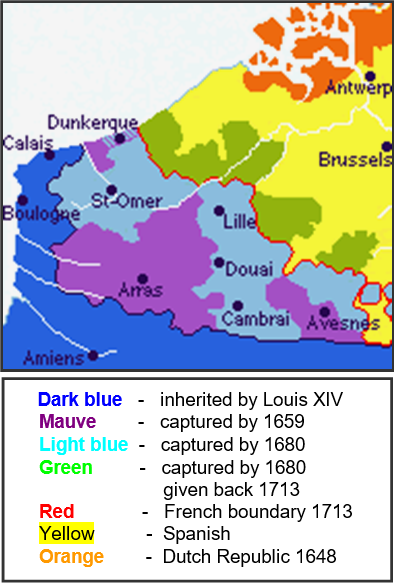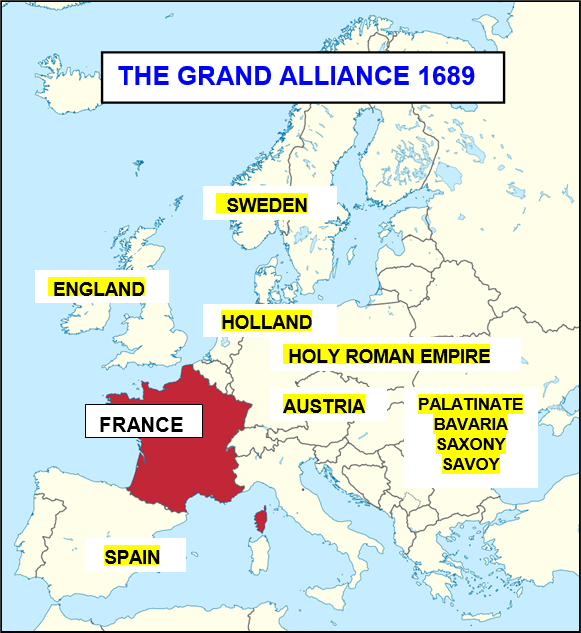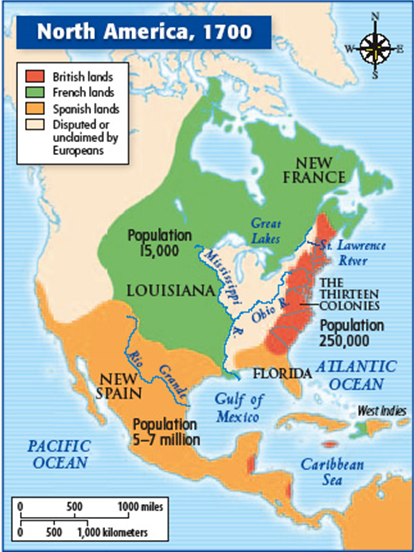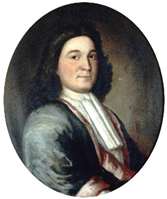


xxxxxAs we have seen, on coming to power in 1661(C2), Louis XIV of France embarked on a campaign of conquest. He gained part of the Spanish Netherlands at the Treaty of Aix-
THE WAR OF THE GRAND ALLIANCE also known as
THE WAR OF THE LEAGUE OF AUGSBURG
1688 -
Acknowledgements
Map (Netherlands): from https://faculty.history.wisc.edu/Sommerville. Map (Europe): licensed under Creative Commons – commons.wikimedia.org. Map (North America): licensed under Creative Commons – https://apworldhistorywiki.wikispaces.com. Phips: attributed to the English painter Thomas Child (died 1706).
 xxxxxAs we have seen, on coming to power in 1661(C2), Louis XIV of France was soon embarked upon a series of expansionist wars. In the War of Devolution, in which he claimed that, following the death of his father-
xxxxxAs we have seen, on coming to power in 1661(C2), Louis XIV of France was soon embarked upon a series of expansionist wars. In the War of Devolution, in which he claimed that, following the death of his father-
xxxxxHis next target was the Protestant republic of Holland, a barrier to his plans to expand northwards. In 1672 he launched a full scale invasion and was soon in possession of three of the seven provinces. But the opening of the dikes around Amsterdam put an end to the French advance, and by 1674 the Dutch, supported by Spain, the Holy Roman Emperor and the Elector of Brandenburg, had regained their lost territory. As a consequence, the French now switched their attack to the Spanish Netherlands. When the conflict finally came to an end, settled by the Treaties of Nijmegen of 1678 and 1679, the French had gained Franche Comté together with Artois and sixteen fortified towns in Flanders.
xxxxxThis blatant policy of aggression by Louis XIV, together with his revocation of the Edict of Nantes in 1685, stiffened the resolve of Protestant Europe. In 1686 the League of Augsburg was formed between the Holy Roman Empire, Spain, Sweden, the Palatinate and the electors of Saxony and Bavaria.
xxxxxUndeterred, in 1688 Louis invaded the Palatinate (in the Rhineland), bent on further gains in the north. This time, however, he saw the stakes as much higher. The Habsburg ruler of Spain, the frail and feeble-
 xxxxxThe French quickly conquered and devastated the Palatinate, but in 1689 William of Orange, now William III, brought both Britain and Holland into the League of Augsburg, and formed what came to be known as The Grand Alliance. Despite this show of unified strength, the French won a series of victories in the Low Countries, including the battles of Steenkerke in 1692 and Neewinden a year later. They also defeated the duke of Savoy at Marsaglia in 1693 (in the Italian Piedmont), and alarmed the Spanish by invading Catalonia. In the same year, however, Louis XIV failed to take Liège and never took part in a battle after this. Furthermore at sea, despite an early victory over the Dutch and English at Beachy Head in 1690, the French fleet was almost totally destroyed at the Battle of La Hogue two years later (sometimes known as the Battle of Barfleur), thus putting an end to their plans to invade England.
xxxxxThe French quickly conquered and devastated the Palatinate, but in 1689 William of Orange, now William III, brought both Britain and Holland into the League of Augsburg, and formed what came to be known as The Grand Alliance. Despite this show of unified strength, the French won a series of victories in the Low Countries, including the battles of Steenkerke in 1692 and Neewinden a year later. They also defeated the duke of Savoy at Marsaglia in 1693 (in the Italian Piedmont), and alarmed the Spanish by invading Catalonia. In the same year, however, Louis XIV failed to take Liège and never took part in a battle after this. Furthermore at sea, despite an early victory over the Dutch and English at Beachy Head in 1690, the French fleet was almost totally destroyed at the Battle of La Hogue two years later (sometimes known as the Battle of Barfleur), thus putting an end to their plans to invade England.
xxxxxThis defeat, together with the constant demands of the land campaign upon his army and his purse, eventually brought Louis XIV to the negotiating table, and, as we shall see, the war was brought to an end by the Treaty of Ryswick in 1697. Despite their sustained effort and string of victories, it was not a favourable settlement for the French. The Sun King was still a force to be reckoned with, but the sun itself was beginning to set on French dominance in Europe, at least for the immediate future. The War of the Spanish Succession (AN 1702) was to see to that.
xxxxxIncidentally, in 1692 the French military engineer Sebastien de Vauban took the fortified town of Namur with comparative ease, but three years later it was recaptured by William III. Considered as one of the king's finest military achievements, the siege and taking of the fortress is described in vivid detail in the novel Tristram Shandy, published in nine volumes by the English writer Laurence Sterne over the years 1759 to 1767. And soon after the event, the English diplomat and poet Matthew Prior wrote his An English Ballad on the Taking of Namur, published in 1695. ……
xxxxx…… In 1694 William’s war against the French suffered a severe blow when in March of that year HMS Sussex sank with all hands during a storm in the Strait of Gibraltar. Apart from the loss of 560 lives, the warship was carrying some nine tons of gold, money being sent to the Duke of Savoy to gain his support in the war. In the early years of the 21st century a search was mounted to recover the bullion, estimated to have a current value of £2.5 billion and lying more than half a mile below the surface.
Including:
King William's War

xxxxxWar in Europe brought conflict between the English and French in North America. Known as King William’s War, it began in 1690. The French, holding part of Canada known as “New France”, launched an attack upon the English colonies and caused heavy casualties. In response the English began a land and sea assault upon Quebec, but the army failed to reach the city and the naval force found it too well defended. After this the war degenerated into a series of border skirmishes until brought to an uneasy peace by the Treaty of Ryswick in 1697. As we shall see, the conflict (Queen Anne’s War) was resumed when the War of the Spanish Succession began in earnest in 1702 (AN).
 xxxxxA by-
xxxxxA by-
xxxxxKing William's War (also known as the first of four French and Indian wars) began in earnest in 1690 when the Comte de Frontenac, the newly appointed governor of New France, arrived in the colony. In response to an earlier attack on the French settlement of Lachine by Iroquois Indians - ck upon the English frontier. The English suffered heavy casualties, particularly during the attacks on Schenectady and the Salmon Falls, and, in retaliation, set out to capture the ultimate prize, the French city of Quebec. A
ck upon the English frontier. The English suffered heavy casualties, particularly during the attacks on Schenectady and the Salmon Falls, and, in retaliation, set out to capture the ultimate prize, the French city of Quebec. A
xxxxxThis violent clash of interests marked the beginning of a series of armed conflicts between the English colonies and their rival Europeans. These cruel and bloody wars, often forming part of a larger conflict in Europe, and inevitably involving rival Indian tribes, raged for over seventy years, and did not come to an end until 1763 (G3a), when the Peace of Paris stripped France of its North American empire.
xxxxxIn the meantime however, as we shall see, the War of the Spanish Succession which began in earnest in 1702 (AN) found England at war with both France and Spain. Thus when the conflict was resumed in North America (known as Queen Anne's War) the English colonists found themselves at war on two fronts -
xxxxxIncidentally, after his naval career was over, Sir William Phips was appointed the first governor of the province of Massachusetts Bay. He arrived there at the height of the famous Salem Witch Hunt of 1692. He established a special court to conduct the trials, but, when matters got out of hand, he suspended the trials and, in May 1693, released the remaining prisoners (including his own wife!).
W3-


